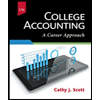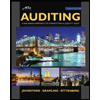Analyze each of the following transactions by showing its effects on the accounting equation—specifically, identify the accounts and amounts (including + or −) for each. January 1 Purchased equipment for $33,000 cash. Estimated useful life is six years and salvage value is $7,920. January 2 Paid $6,600 cash to install automated controls on equipment. This betterment did not impact useful life or salvage value. August 15 Paid $260 cash for minor repair costs to equipment.
Analyze each of the following transactions by showing its effects on the accounting equation—specifically, identify the accounts and amounts (including + or −) for each. January 1 Purchased equipment for $33,000 cash. Estimated useful life is six years and salvage value is $7,920. January 2 Paid $6,600 cash to install automated controls on equipment. This betterment did not impact useful life or salvage value. August 15 Paid $260 cash for minor repair costs to equipment.
Intermediate Accounting: Reporting And Analysis
3rd Edition
ISBN:9781337788281
Author:James M. Wahlen, Jefferson P. Jones, Donald Pagach
Publisher:James M. Wahlen, Jefferson P. Jones, Donald Pagach
Chapter3: Review Of A Company's Accounting System
Section: Chapter Questions
Problem 5GI: Explain how the accounting equation organizes financial information using T-accounts and debits and...
Related questions
Question
100%
Analyze each of the following transactions by showing its effects on the
| January 1 | Purchased equipment for $33,000 cash. Estimated useful life is six years and salvage value is $7,920. |
|---|---|
| January 2 | Paid $6,600 cash to install automated controls on equipment. This betterment did not impact useful life or salvage value. |
| August 15 | Paid $260 cash for minor repair costs to equipment. |

Transcribed Image Text:This image represents a financial accounting template designed to help users organize and understand the fundamental accounting equation: Assets = Liabilities + Equity. The template is divided into three main sections: Assets, Liabilities, and Equity. Each section includes several rows for itemization and calculation.
**Sections:**
1. **Assets:**
- The first column is labeled "Assets," which lists the resources owned by an individual or entity.
- There are multiple rows provided for the entry of different asset types.
- Each row includes an equal sign ("=") indicating where the total assets should equal the sum of liabilities and equity.
2. **Liabilities:**
- The second column is labeled "Liabilities," which accounts for obligations or debts owed.
- Similar to the assets section, multiple rows are available for itemization.
- Each entry aligns with a corresponding equal sign for calculating the total liabilities.
3. **Equity:**
- The third column is labeled "Equity," representing the owner's interest in the assets after liabilities are deducted.
- Each entry space is aligned with a plus sign ("+") indicating how equity plus liabilities should total to the assets.
This table is intended to facilitate a clear visual understanding of how assets are balanced by liabilities and equity in accounting practices.
Expert Solution
This question has been solved!
Explore an expertly crafted, step-by-step solution for a thorough understanding of key concepts.
This is a popular solution!
Trending now
This is a popular solution!
Step by step
Solved in 2 steps

Knowledge Booster
Learn more about
Need a deep-dive on the concept behind this application? Look no further. Learn more about this topic, accounting and related others by exploring similar questions and additional content below.Recommended textbooks for you

Intermediate Accounting: Reporting And Analysis
Accounting
ISBN:
9781337788281
Author:
James M. Wahlen, Jefferson P. Jones, Donald Pagach
Publisher:
Cengage Learning

Principles of Accounting Volume 1
Accounting
ISBN:
9781947172685
Author:
OpenStax
Publisher:
OpenStax College

College Accounting, Chapters 1-27
Accounting
ISBN:
9781337794756
Author:
HEINTZ, James A.
Publisher:
Cengage Learning,

Intermediate Accounting: Reporting And Analysis
Accounting
ISBN:
9781337788281
Author:
James M. Wahlen, Jefferson P. Jones, Donald Pagach
Publisher:
Cengage Learning

Principles of Accounting Volume 1
Accounting
ISBN:
9781947172685
Author:
OpenStax
Publisher:
OpenStax College

College Accounting, Chapters 1-27
Accounting
ISBN:
9781337794756
Author:
HEINTZ, James A.
Publisher:
Cengage Learning,

Financial Accounting: The Impact on Decision Make…
Accounting
ISBN:
9781305654174
Author:
Gary A. Porter, Curtis L. Norton
Publisher:
Cengage Learning

College Accounting (Book Only): A Career Approach
Accounting
ISBN:
9781337280570
Author:
Scott, Cathy J.
Publisher:
South-Western College Pub

Auditing: A Risk Based-Approach to Conducting a Q…
Accounting
ISBN:
9781305080577
Author:
Karla M Johnstone, Audrey A. Gramling, Larry E. Rittenberg
Publisher:
South-Western College Pub